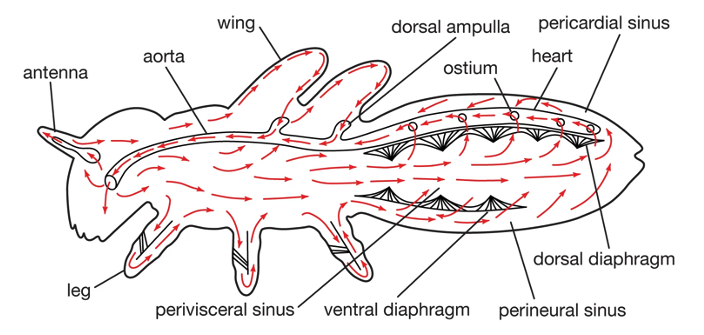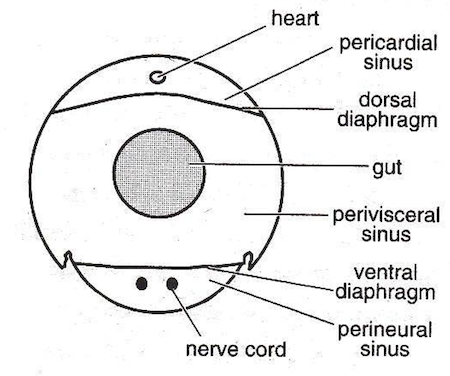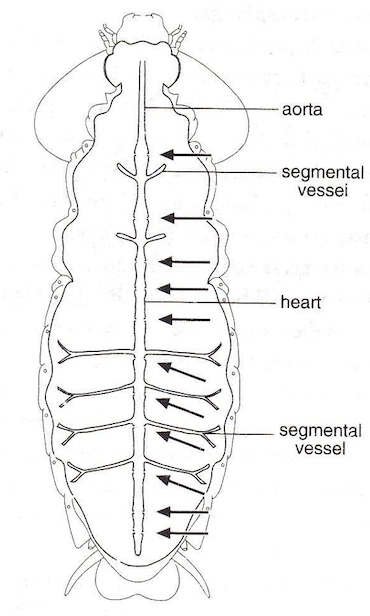🫀 Circulatory System
Aorta, Heart, Ostia, Accessory pulsatile organs, Process of blood circulation, Properties of blood and Functions of Blood
Which of the following statment is incorrect?

- In insects the
open circulatory systemis found while in mammals found closed circulatory system. - The insect blood is known as
hemolymphwhich is color less fluid having plasma and blood cells i.e.,haemocytes. - The body cavity that contains circulatory fluid i.e., haemolymph known as
haemocoel. - Basic functions of haemocytes are generally same as the functions RBC and WBC in mammalian blood.
- The principal function of haemocytes is phagocytosis (ingestion of harmful foreign materials).
- The major blood sugar in insects is a disaccharide i.e., trehalose.
- In insect circulatory system the main pump is pulsatile dorsal vessel which is anterior part called as aorta and posteriorly hearts.
- Haemocoel of the insects is divided into 3 sinuses or regions due to the presence of two fibro muscular septa or diaphragms composed of connective tissues.

Main sinuses of haemocoel
- Dorsal or Pericardial Sinus: The area lying in between the tergum and dorsal diaphragm. It contains heart.
- Ventral or Perineural Sinus: The area lying in between the sternum and ventral diaphragm. It contains nerve cord.
- Visceral Sinus: The area in between dorsal and ventral diaphragms. It harbours the visceral organs like alimentary canal and gonads.
Dorsal Blood Vessel
- It is the principal blood conducting organ in insects which remain closed at the posterior end and opens anteriorly into the head.
- It is divided into an anterior aorta and posterior heart extending throughout the length of the body.
Aorta
- It is the anterior part of the dorsal blood vessel and functions as principal artery. It is present in the thoracic region and opens into the head near the brain.
- Its attachment with the heart posteriorly is marked by an aortic valve. Anteriorly sometimes it gets divided into 2 or more cephalic arteries in the head.
Heart
- It is the posterior part of dorsal blood vessel extending up to the terminal end of the abdomen.
- Heart remains in position with the help of alary muscles that are attached to the tergum of the abdomen on one side and to the dorsal diaphragm on other side.
- These alary muscles appear to be distributed fan like over the heart.
- Heart consists of number of chambers marked by constrictions and the presence of the opening called
ostiawhich allow the entry of blood from pericardial sinus into the heart. - The number of ostia depends upon the number of heart chambers.
- The ostia permit the one-way flow of haemolymph into the dorsal vessel due to valves that prevent backflow.
- There may be up to three pairs of thoracic ostia and nine pairs of abdominal ostia i.e. total
12 ostia. - All 12 pairs are present in the Dictyoptera (
Grasshopper). - The wall of heart also consists of muscles.
- Heart mainly functions as the pumping organ into the aorta.

Accessory pulsatile organs
- Insects consists of sac like structures called accessory pulsatile organs, which are present at the base of the appendages such as wings, legs, and antenna. They pulsate independently and supply adequate blood to the appendages.
Process of blood circulation
- Heart mainly functions as a pulsatile organ whose expansion and contraction leads to blood circulation.
- It takes place generally in an anti-clock manner starting from posterior end to the anterior end in a forward direction.
- Circulation of blood takes place in two phases due to the action of the alary muscles as well as the muscles of the walls of the heart.
- The two phases are:
- Diastole: During which expansion of heart takes place.
- Systole: Contraction of heart takes place.
- Diastasis: In between diastole and systole there will be a short period of rest which is known as diastasis.
Properties of blood:
- Blood is colourless or green or yellowish with different types of haemocytes and plasma. Green colour is due to chlorophyll dissolved in the plasma and red colour is due to haemoglobin in Chironomus midge.
- Blood covers up 5 – 40% of the total body weight that vary with the sex and stage or age of the insect.
- Insect blood contain proteins, lipids, sugars, organic acids, phosphates, pigments, uric acid etc.
- The insect blood of phytophagous insect is rich in ‘K’ whereas that of carnivores are rich in ‘Na’
- Specific gravity of the blood varies from 1.01 to 1.06.
- pH of the blood generally varies from 6-7.
- The blood sugar of insects is
trehalose.
Functions of Blood
- Transport of minerals or food materials: blood transports minerals, digested products, hormones to different parts of the body.
- Blood stores water for the tissues.
- Helps during the process of moulting for splitting up of the old cuticle.
- Encapsulation: to protect from the large metazoan parasites, the haemocytes of blood, become aggregated around the foreign body forming a capsule of 2-3 layers. This leads to the death of the foreign bodies due to lack of O2 supply.
- Phagocytosis: to get protection from micro-organisms like bacteria, viruses and fungi, the haemocytes completely engulf the foreign body and gets autolysed (this is the principal function of haemocytes)
- Immunity: blood gives immunity by producing antibodies to restrict further infections.
- Connective tissue formation: blood provides lipoproteins that are necessary for the formation of the connective tissue.
- Wound healing or coagulation: haemocytes extend pseudopodia which forms a cellular network over the wounded site or plasmtocytes coagulate forming a plug over the wound or haemocytes are arranged in to multi layered sheaths over the wounded site, thus helping in wound healing.
- Detoxification: As the haemocytes are capable of detoxifying the toxic chemicals, insects get the ability to resist the toxic effects of chemicals.
- Reflex bleeding: It is a phenomenon where emission of blood occurs through the pores or slits of the cuticle which mainly helps the insects for getting protection from their natural enemies.
References
- Insecta - Introduction: K.N. Ragumoorithi, V. Balasurbramani & N. Natarajan
- A General Textbook of Entomology (9th edition, 1960) – A.D. Imms (Revised by Professor O.W. Richards and R.G. Davies). Butler & Tanner Ltd., Frome and London.
- The Insects- Structure and Function (4th Edition, 1998) – R.F. Chapman. Cambridge University Press
- https://www.amentsoc.org/
- Researchgate
- Wikipedia
Which of the following statment is incorrect?

- In insects the
open circulatory systemis found while in mammals found closed circulatory system. - The insect blood is known as
hemolymphwhich is color less fluid having plasma and blood cells i.e.,haemocytes. - The body cavity that contains circulatory fluid i.e., haemolymph known as
haemocoel. - Basic functions of haemocytes are generally same as the functions RBC and WBC in mammalian blood.
- The principal function of haemocytes is phagocytosis (ingestion of harmful foreign materials).
- The major blood sugar in insects is a disaccharide i.e., trehalose.
- In insect circulatory system the main pump is pulsatile dorsal vessel which is anterior part called as aorta and posteriorly hearts.
- Haemocoel of the insects is divided into 3 sinuses or …
Become Successful With AgriDots
Learn the essential skills for getting a seat in the Exam with
🦄 You are a pro member!
Only use this page if purchasing a gift or enterprise account
Plan
Rs
- Unlimited access to PRO courses
- Quizzes with hand-picked meme prizes
- Invite to private Discord chat
- Free Sticker emailed
Lifetime
Rs
1,499
once
- All PRO-tier benefits
- Single payment, lifetime access
- 4,200 bonus xp points
- Next Level
T-shirt shipped worldwide

Yo! You just found a 20% discount using 👉 EASTEREGG

High-quality fitted cotton shirt produced by Next Level Apparel